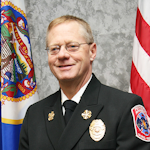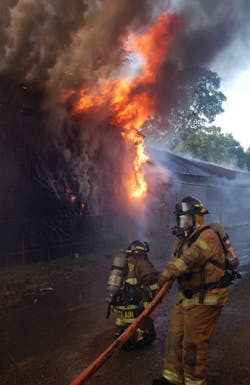20 Tough Questions For the Fire Chief: Are You Prepared To Answer Them? Question 17
The first part of this question insinuates that a change in governance structure is the precursor to enhancing service levels. The second part of the question concludes significant additional investment is required to improve service. In most cases, neither assumption is accurate. Of course, there are many factors and depending on the governance model being used, a change may be necessary to improve service. And, depending on the fire department’s budget, an additional investment may be necessary to improve service quality.
“Begin with the end in mind.” We borrow this principle from the late Stephen Covey. It’s one of his seven habits for highly effective people. To begin with the end in mind, start by having conversations with citizens and elected officials to determine what level of fire department service is appropriate for the community. This includes determining community expectations and evaluating the community’s ability to pay for those expectations.
There is often a gap between expectations and the ability to pay because many elected officials (and most civilians) have no idea what services cost. All they know is when they need the fire department, they want the firefighters there fast; they want them to have the resources (apparatus, equipment and personnel) to handle their emergency effectively; and they want them to have expert problem-solving knowledge and skills.
The governance roadblock
Once the level of service is determined and the cost of service established, the next step is to determine whether the governance model facilitates or prohibits the service-level expectations. If it is determined to be prohibitive, then the department and elected officials could work to identify how to fix the problem. It may be a new governance model isn’t necessary. Rather, making adjustments in the existing model may be sufficient.
Developing a new governance model can be a costly and labor-intensive process. Additionally, it may solve one problem and create others. For example, it may be determined that several jurisdictions should combine and the new governance model would be a fire district board of directors. Who makes up the board, what interest they represent and how voting powers (control) are assigned may create a challenging environment in which to enhance service. If two communities combine and each have an equal representation on the board, it could become messy if one community wants to enhance service quality when then other does not.
Occasionally, based on the laws of a state, county or municipality, governance could present a roadblock that requires the implementation of a new model. If this is the case, take your time and consider all the stakeholders. Talk with other communities that have adopted similar governance models to glean what works well and what does not. Try to avoid the mistakes they may be regretting.
More money
Does a fire department need more money to improve the level of service? The short answer is: It depends. We encourage you to look back on the previous issues as we have discussed, extensively, how to evaluate the efficiencies of your department.
In some cases, it may be possible for the department to improve service levels with no additional investment. This may be accomplished by seeking ways to provide existing services more efficiently. Some additional ways this could be accomplished include:
• Reducing or eliminating services that are no longer mission-critical (we are referring to those “nice-to-provide” services that some departments started offering when they expanded their mission during good economic times)
• Partnering with other departments within the municipality
• Partnering with neighboring communities to share resources
• Outsourcing services to private entities
• Collaborating with other non-fire agencies in the region to provide services
• Investing in technology to reduce the cost of operations
It should never be assumed that service-level improvements automatically require additional funding. Some enhancements may be achievable within the limitation of the existing budget and staffing. For example, if the fire department wants to enhance service by promoting community wellness, it could (in most cases) conduct blood pressure clinics, on-site blood sugar screening or drive-through flu shots at a very low cost. If, on the other hand, the desired service-level improvements include reducing the average response time for the arrival of first-alarm companies to a residential dwelling fire (e.g., two engines, a ladder, a command officer and 13 firefighters) to under 10 minutes, it may require an additional investment for on-duty staffing or entering into an automatic aid agreement with a neighboring community.
A lesson in economics
Everything the fire department does (or does not do) has a cost. There are several ways to evaluate the cost of services including:
• Fixed costs – This is what it costs taxpayers to have an operational and functional fire department. These costs would be incurred even if the fire department did not run a single call for the year. Examples include buildings, utilities, apparatus, equipment, non-usage-related maintenance and repairs, training, insurance and on-duty staffing. Using a personal example, if you own a vacation home, there are fixed costs associated with the purchase price of the home and payment of property taxes regardless of whether you ever use the home.
• Variable costs – Sometimes called incremental costs, this is what it costs taxpayers for the fire department to actually provide services when called upon. This includes fuel, usage-related repairs and maintenance, callbacks and fire and medical supply replacement. Using the vacation home example, this would be the cost of travel to and from the vacation home, utilities and the cost of activities you incur while using the vacation home that you would not have otherwise incurred if you did not use the home.
• Direct costs – These are the costs that can be directly attributed to a particular service. For example, when there is a structure fire, there are costs associated with that response. In other words, just like a company can determine the cost of production for a product (e.g., the labor, raw materials and machining cost to produce a widget), a fire department can determine the cost for each service provided. Using the vacation home example, these costs may include upgrades like new carpeting or installing a swimming pool.
• Opportunity costs – The cost of opportunity lets the fire department determine the cost of what it CANNOT do because the members are busy doing something else. For example, if the fire department provides full-service EMS with transportation and this service is very busy (e.g., 10-plus calls per day per company), there is an opportunity cost for the other tasks these firefighters could otherwise be doing if they were not so busy providing EMS services. In other words, if the firefighters were not providing EMS (or providing a scaled-down version of EMS), what else could they be doing? What is the cost of NOT providing the alternative service? Using the vacation home example, the opportunity costs are all the other things you could have done with the money you invested into your vacation home. It also includes all the other things you could have been doing with your time while you spent it at your vacation home.
Getting what you need
The bottom line is, governance and funding levels are rarely determined by the fire department’s administration. The elected officials are the ones charged with the responsibility for both. However, this does not preclude the fire department from advocating for the best governance model and appropriate levels of funding.
This advocacy begins by having good working relations with elected officials, educating them on the fire department’s needs, educating them on those needs and their costs and working with them collaboratively to provide the best model and funding that meets the needs of your community.
RICHARD B. GASAWAY, Ph.D., has served for more than 30 years in public safety, including 22 years as a chief fire officer. He holds bachelor’s, master’s and doctor of philosophy degrees in finance, economics, business administration and leadership. Dr. Gasaway operates the Situational Awareness Matters! website (www.SAMatters.com). He provides programs on firefighter safety and leadership to departments throughout the United States and Canada. Dr. Gasaway also hosts the Leader’s Toolbox podcast radio show on Firehouse.com. RICHARD C. KLINE has been the fire chief for the City of Plymouth, MN, since 1992 and is a senior associate at the Gasaway Consulting Group. He holds a master’s degree in public safety and is a credentialed chief fire officer through the Commission on Public Safety Excellence. Kline is the chairman of the Minnesota State Fire Chief Association’s Safety and Health Committee. The authors can be reached at: [email protected] or 612-548-4424.

Richard Kline
RICHARD C. KLINE is a 40-year fire service veteran who recently retired from the Plymouth, MN, Fire Department, following 23 years of service as fire chief. He is a frequent regional and national speaker who covers topics that relate to command competencies and firefighter safety and health. Kline can be contacted at [email protected].






